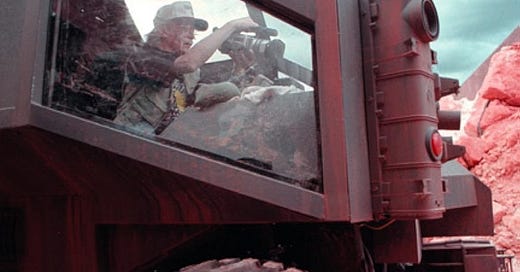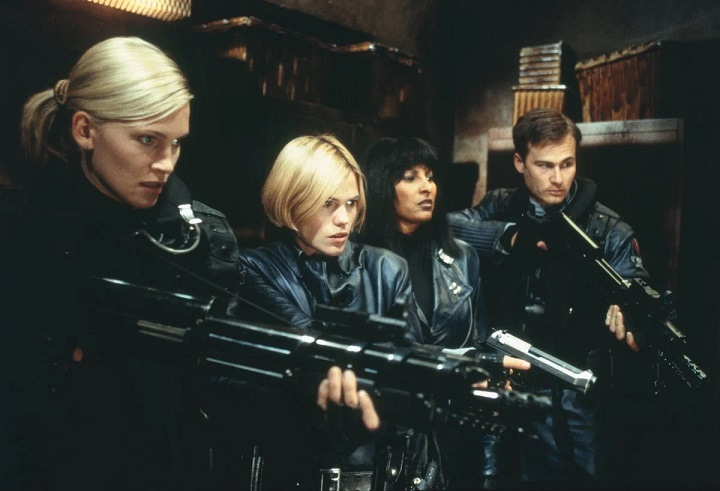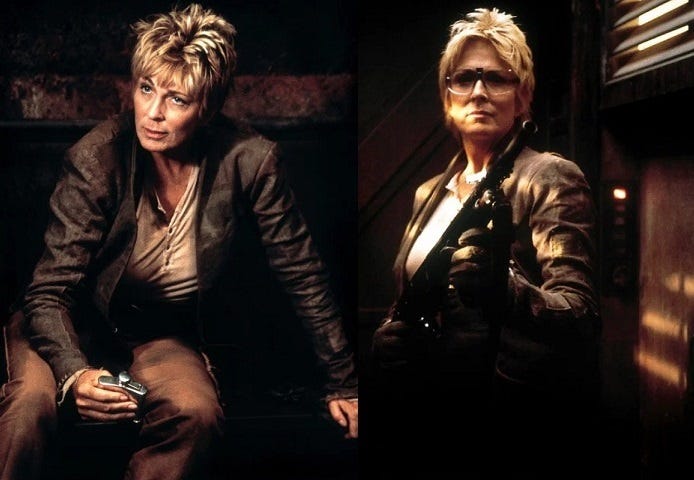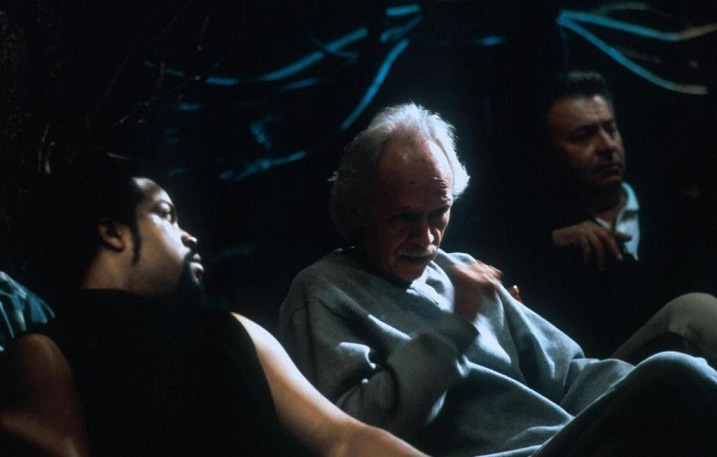John Carter of Mars was the previous title of John Carter (2012). John Carpenter directed Ghosts of Mars (2001), but directing John Carter would have been like Bruce Payne being almost cast as Bruce Wayne in Batman (1989). In the May 2001 issue (#131) of a French magazine called Mad Movies, there was a five page feature on Ghosts of Mars. But that was just a warm-up to the fourteen page feature in the November 2001 issue (#136). The female empowerment premise of a 2176-era Earth being ruled by women would have been seen as a parody of woke had it been made two decades later. The film finished filming a couple of months before Jason Statham worked on Jet Li’s The One. While that was produced by Columbia, this earlier film was produced by another Sony company: Screen Gems. As Carpenter put it: “It's a difficult situation to summarize, but it turns out that Ghosts of Mars is the first film produced by Screen Gems. This Sony-affiliated firm is a bit like what Dimension represents to Miramax and Disney. Their goal is to produce small genre films for $15 million. With Ghosts of Mars costing twice as much, we found ourselves facing a production problem from the start. Since I didn't want to give in, I left of my own accord. And finally, some time later, the people at Sony reversed their decision, accepting the budget presented to them.”
With the project back on track, Whoopi Goldberg was briefly contacted for a role in the film. Although interested, she quickly backed out. Initially, Ghosts of Mars revolved around Melanie (Natasha Henstridge) and Williams (Ice Cube) but the script was changed to accommodate Jericho (Statham). In 2001, the film was released in the U.S. on August 24 but post-production had not been completed by the time that the May 2001 issue of Mad Movies was published. In the issue, producer Sandy King (Mrs. John Carpenter) mentioned in her one page interview that she was concurrently working on a sequel to Carpenter’s Vampires that was directed by someone else - the director of Halloween III: Season of the Witch. Sandy discussed the origin of Carpenter’s Martian movie: “A little less than two years ago. He told me the outline of the story and what he wanted to do with it. With the treatment he had written, we began looking for financing, notably by going to the Cannes Film Festival. We didn't have too much trouble selling the project on his idea and John Carpenter's name. Then John developed the script with Larry Sulkis, and everything happened pretty quickly.”
Alexandre Nahon translated Vincent Guignebert’s question about what Sandy thought of the script: “I found it very funny, like a great popcorn movie! People always say that John makes Westerns in disguise. This is especially true since no one wants to give him money to make a real one. Well, Ghosts of Mars is a cross between The Wild Bunch and The Longest Day! When I read the script, I kept thinking that it sounded like what John does best.”
John claimed that Ghosts of Mars was influenced by Zulu as was Assault on Precinct 13. He got into the habit of shooting quickly and sometimes doing only one take of the scene. When he was making Village of the Damned (1995), John said: “We save time, and it also allows us to maintain a certain creative control over the studio people if they ever try to poke their noses into the editing.”
Sandy was asked what major problems that she had to solve on this project: “Pretty much everything! It was a complicated film to set up, largely because we had to create an imaginary world on another planet.”
Her work process: “I was constantly on set. It's quite simple: I had my office transferred to the set, using the second half of the buildings we had constructed! In the morning, I would go to the set before filming began and stay there until evening. This allows us to make decisions quickly and resolve certain problems more easily. It's a considerable time saver. While filming in the New Mexico desert in the middle of summer, the worst season, we experienced terrible weather conditions: torrential rains, sandstorms... My job was to make sure filming continued anyway. Being on location allowed me to coordinate my work with the weather services. Anyway, being on set is useful, and I enjoy it. I'm more interested in the making of the film than in financing it. I do the money because it's necessary, because you have to start there, but it's the making of the film that I enjoy.”
Her nickname is Mother Production: “(Laughs) People started calling me that over ten years ago. As a producer, I've always tried to make everyone's life easier: the director, the crew, the studio staff. In my opinion, the best producers are those who take as much care of the crew as they do the film. I'm always concerned about the people who work for me, and I value the atmosphere on set. As a result, some people started calling me "Mom." I admit it was a little hard to get used to, because I consider myself much more "rock 'n' roll" than that. But hey, sometimes you get ideas about yourself!”
The film’s co-writer, Larry Sulkis, was interviewed by Stéphane Moïssakis. Larry said: “I met John Carpenter while filming They Live. I had known Sandy King for over fifteen years at the time. I was directing documentaries for MTV and Showtime when she asked me to help them with certain aspects of the film. I first directed the segments broadcast on TV, the ones pirated by the rebellion. Then I took care of promoting the film, which was number one at the box office during its opening weekend. Later, I worked on some scripts for them, including Captain Blood, Dark Flame, and Village of the Damned, for which I am not credited even though I worked on the last three versions. After a long and varied collaboration, the script for Ghosts of Mars is my first real joint work with John.”
The starting point: “John called me in June 1999 to work on Ghosts of Mars. We met at a coffee shop on Sunset, and he showed me his treatment and a character bible. He asked if I'd be interested in developing the script with him. The project sounded really entertaining, so I accepted without hesitation. I went home and ruminated for days without being able to write a line. Then suddenly, it came to me by itself, and I wrote the first draft in a week, which wasn't long. John and I started from that base and refined the script over the next three months.”
Larry’s evaluation of Carpenter: “John is a master of his craft. A highly cultured person who knows a tremendous amount about the history of cinema and its technique. But at no point does he flaunt his knowledge. On the contrary, he is very attentive to others' suggestions. Since the first draft was very linear in its description of the action, we reworked the script to provide surprises for the audience. The fun part of working together was seeing him get excited like a child imagining what a line we had just written would sound like coming from an actor. He is really good at loosening up dialogue so that the emotion finds its place. Sandy King also pointed us in the right direction for the female characters' dialogue. We really had to imagine ourselves in our characters' shoes to make the world of Ghosts of Mars totally believable.”
The film was released in France on November 2001. In that month’s issue of Mad Movies, the title of the article was Total Western. This was a reference to Arnold Schwarzenegger’s Total Recall (1990). In his four page interview for Rafik Djoumi and Stéphane Moïssakis, John Carpenter said: “I've wanted to make a film about Mars since the 1980s. I've loved science-fiction since I was a kid, and one of my favorites has always been Forbidden Planet. Plus, I hadn't made a sci-fi film in a while. Over the years, I began to envision Mars as a new frontier, like the American West once was, a place where you might find small, primitive towns connected by a railroad. And the story slowly evolved from that concept. But overall, the situations presented were a good excuse to make a Western in the spirit of Rio Bravo or 3:10 to Yuma.”
The narrative structure: “The first draft of the script was linear. Everything was in order. But the result was far too gothic. One of the solutions to avoid this and move towards a Western was to shake everything up and tell the story through the heroine's eyes, therefore in flashbacks.”
The drug use of the character played by Natasha Henstridge: “It's interesting that you point that out. The film was recently screened at the Venice Film Festival, and one of the critics was very shocked by it. He asked me, "How can you indulge in the immorality of this woman who takes drugs?" What was he talking about? What immorality? I'm a product of the sixties! All my friends and I still smoke marijuana. I know quite a few people in the United States who take drugs. And elsewhere, they'd all be clean? I still don't understand what he meant. What is immorality?”
The mood and age of the audience: “These things change every year. Until very recently, until September 11th to be exact, a good part of the young American public considered sincerity something stupid, old-fashioned. That may no longer be the case. I'm not being cheaply cynical when I mention this. I take it very seriously.”
This is why his films do better on video: “They perform much better in the long run; this is a fact that has been verified every time and for a very long time. My films can be cynical, but not unnecessarily so, not in a "pop-style" way. In that sense, they don't follow fashion, as films like Scream can, which is the very epitome of cheap cynicism.”
To take a break from this translation, I should note that cast member Clea DuVall criticized the Merriam-Webster definition of feminism on Twitter circa late April 2016: “When you see it written out like this, it's a wonder why feminism gets such a bad rap.”
Now onto the female empowerment premise where Carpenter said: “The idea of a futuristic matriarchal society was born from an exercise in logic, in fact. Suppose you are in the future and the Earth is overpopulated, the environment is destroyed, resources are exhausted. Then, perhaps the patriarchal system would be shaken up. Matriarchy would begin by naturally regulating the birth rate, and would logically replace competition with collaboration. I started on this basis. And what's more, I needed a good excuse for women to be able to accomplish all these actions without having to prove anything to the surrounding males. Now, sexual characteristics don't change much. We still find smooth-talking guys like Jason Statham's character Jericho or tough guys like Ice Cube's Desolation Williams. Unless, of course, we all become eunuchs.”
About the claustrophobic shootfight in a hallway: “The idea for the gunfight in Ghosts of Mars comes from the film Zulu. The English had a combat tactic that we reused here. They had two lines of shooters: the first line fired while the second reloaded, then the groups changed position. This allowed them to retreat while still receiving heavy fire. I had four characters, and it was entirely possible for me to have them apply the same strategy. It's simply a matter of killing as many people as possible, never turning your back on the enemy. And it's, above all, a tribute to Zulu.”
John Carpenter referencing a film that he was considered to direct: “It's mainly the test screenings that are problematic. When a group of morons starts telling you what your movie should be like, you're on the wrong track. Deciding to remake a movie after a screening can only make it worse. Only Fatal Attraction was a success when they replaced the downbeat ending with a new, revenge-fueled ending. And since then, that example has justified everything for them. Put yourself in the shoes of a studio boss. All you're trying to do is find a valid excuse to cope with failure, knowing that, in reality, nine out of ten movies flop. It's a terrible business. And anyway, they didn't do a test screening for Ghosts of Mars.”
His take on the box office failure: “It came out at a really bad time. By the end of the summer, people were tired of action movies. Plus, they marketed it as a black film, putting rap in the trailer.”
Jean-Pierre Michalon was the translator for Julien Dupuy and Vincent Guignebert when Sandy King was interviewed. She said: “We chose to film on the Zia Indian Reservation. In the United States, Indian reservations generally have their own laws based on treaties with the government. The Zias are the only ones who have never signed a treaty with the United States. And this turned out to be very practical in our case. Because you should know that there were, in New Mexico, particularly severe fires during the season preceding our shoot, and many forests had been affected south of where we had built our set. If we hadn't been in a place devoid of any vegetation and on an Indian reservation exempt from the laws in force in the United States, we would never have been able to film. At least, we would never have been able to blow up and burn an entire set in the middle of a fire-prone national park.”
Weather: “Because of the producers at Screen Gems, we were forced to shoot in July. However, on the desert plateaus of New Mexico, during the month of July, there are constant thunderstorms and a high density of lightning. I don't think we had two days of shooting without a storm. Which is annoying, to say the least, especially for a film supposed to take place on Mars! Now, I remind you that we had repainted a white gypsum mine with red paint. For ecological reasons, we had used a biodegradable vegetable paint, and each time it rained, our planet began to disappear. It was like exposing water-based paint to torrents of water. Every day, we had to repaint our set. In the end, we had to use 460,000 liters of paint!”
Riding out the lightning: “New Mexico has the highest number of lightning deaths, so we equipped all the buildings with lightning rods. But there was still the problem of the electrical generators, which were connected by cables to all the production buildings and the set. If these were struck by lightning, we were no longer safe anywhere. So we established constant contact with a meteorologist in Albuquerque who did a nightly weather report on a local television station. We set up an alarm system, namely a beeper and a cell phone exclusively for him. If a storm approached within seven kilometers of where we were shooting, he would beep us and then tell us how long the storm would last, where it was heading, and where it would hit. And I must admit that he was 100% right every time. I have never seen such a reliable weatherman. The crew members were really afraid of being struck by lightning. They were very nervous, but after only a few days of filming, the guys trusted him completely.”
Screen Gems: “I'll tell you the truth: it was very difficult to work with them. All the majors now have these subdivisions that pretend they're independent, which isn't true. When you work for Dimension, you're working for Miramax, so you're working for Disney. And when you work for Screen Gems, you're actually working for Sony. And sometimes these departments have their rivalries, their jealousies, their financial incompetence - all these problems you have to deal with. Screen Gems existed before it was bought by Sony, but hadn't really produced any films. When we began production on Ghosts of Mars, Screen Gems didn't yet have a physical existence. We had to initially go to Columbia, which had different laws. In addition, there was a lot of rivalry between all these Sony divisions, and I constantly had to report to different people, whereas usually, I deal with a single studio executive. So it was very complicated; it's definitely not the ideal situation for a producer. Moreover, once attached to Sony, this subdivision had one imperative: to compete with Dimension by initiating productions worth ten million dollars. We definitely had nothing to do with this scheme, and it certainly didn't help our business.”











